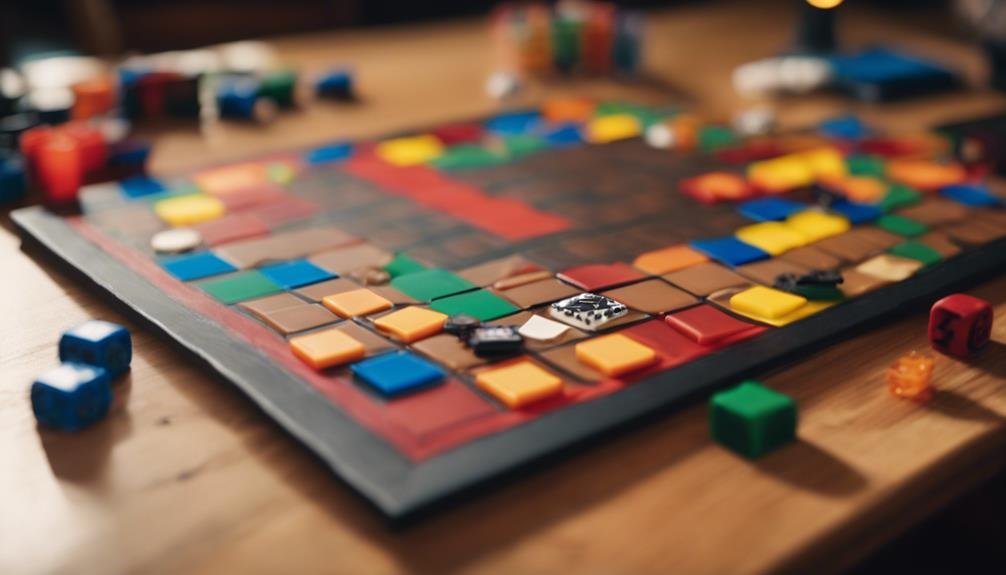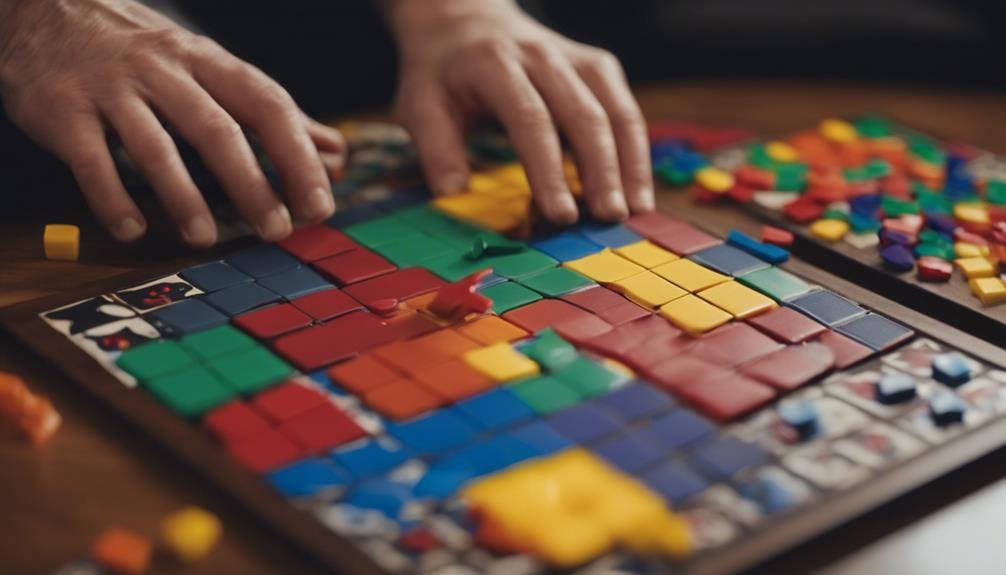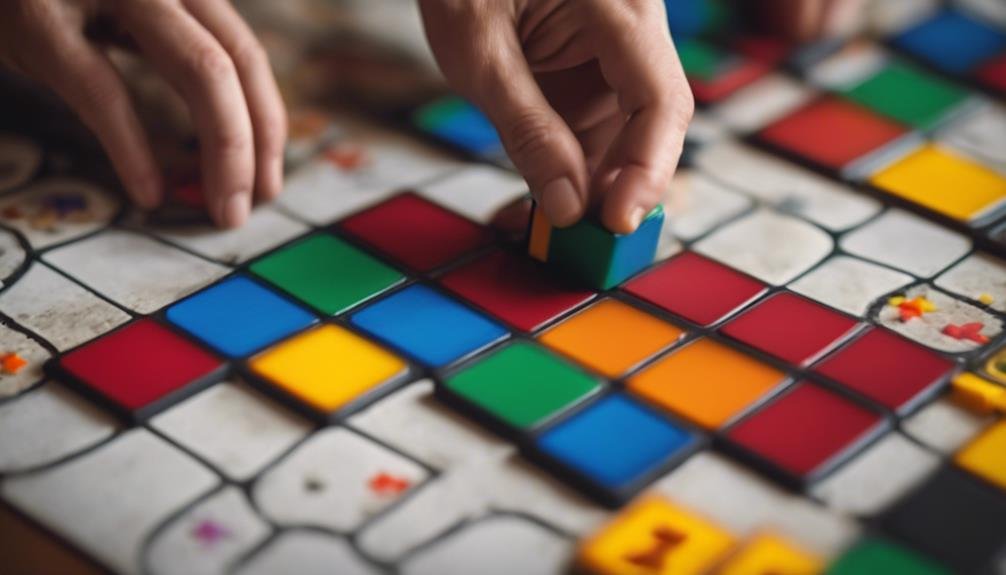When you sit down to play Qwirkle, the first step is drawing six tiles from the bag and forming an initial grid, but there’s more to it than just placing tiles randomly. You’ll need to think strategically from the outset, considering how to create the longest lines of matching colors or shapes. The game starts with the player who can form the longest line, setting the stage for a series of tactical moves. But what happens when your tiles don’t fit anywhere or when you aim for that coveted ‘Qwirkle’? Understanding these nuances can make all the difference.
Key Takeaways
- Draw six tiles each and keep them hidden from others.
- Match tiles by color or shape to form lines on your turn.
- Score points by extending lines and creating Qwirkles.
- Replenish tiles to maintain 6 in hand after each turn.
- The game ends when all tiles are played, and the highest score wins.
Game Setup

Setting up a game of Qwirkle begins with each player drawing six tiles from the bag to form their initial hand. Each tile features a combination of different shapes and colors, creating various possibilities right from the start.
Once everyone has their tiles, you’ll look for the player with the longest line of tiles that share the same shape or color. That player goes first.
To start the game, the first player lays down one or more tiles to form the initial grid. As you can see, the tiles can align based on matching shapes or matching colors, but not both simultaneously. After the first move, turns proceed clockwise around the table.
Each player’s goal during the setup phase is to maximize their potential for future moves. You might find yourself strategizing where to place your tiles to create opportunities for high-scoring lines.
Additionally, don’t forget that the setup is essential for setting the game’s tone and laying the groundwork for the strategic placement of tiles that will follow. With a solid setup, you’re on your way to mastering Qwirkle.
Basic Rules
Now that you’ve set up the game let’s explore the basic rules you need to follow to play Qwirkle. Each player starts with six tiles, and you’ll take turns placing tiles on the board to create lines. Lines can be formed by matching either colors or shapes. You can add tiles to existing lines on the grid, extending them strategically to earn points. Remember, a line must consist of either the same color with different shapes or the same shape with other colors.
A key goal in Qwirkle is to create a ‘Qwirkle’—a line of six tiles that either all share the same color but have different shapes, or all share the same shape but have different colors. Achieving a Qwirkle net you a significant point bonus, so aim for those strategic placements.
Points are accumulated based on the number of tiles in each line you create or extend. For example, if you add a tile to a line of three, you’ll score four points. Finish a Qwirkle, and you’ll get an additional bonus.
The game continues until all tiles have been played, and the player with the highest score at the end wins.
Starting the Game

To begin the game, each player draws six tiles from the bag. Make sure everyone keeps their tiles hidden from the other players.
The next step is to determine who goes first. Each player examines their tiles to see who can create the longest line. A line consists of tiles with the same color or shape but not both. The player with the longest line in their hand gets the honor of starting the game.
Once the first player is identified, they place their tiles on the table to form their line. This initial line sets the stage for the rest of the game. Remember, the key to Qwirkle is creating lines of tiles that either match in shape or color but not both. Players should always aim to add to existing lines or start new ones when placing their tiles.
After placing the initial line, each player replenishes their hand back to 6 tiles by drawing from the bag. Ensure you always have six tiles in your rack at the end of your turn.
Now that you understand starting the game, you’re ready to get into the excitement of Qwirkle.
Playing a Turn
When it’s your turn in Qwirkle, you can either place tiles on the grid to match colors or shapes or exchange unwanted tiles for new ones.
To place tiles, you must add them to existing lines on the grid. The lines can be formed by matching colors or shapes, but each line can’t have duplicate tiles in either color or shape.
To make the most of your turn, follow these steps:
- Survey the Grid: Look at the existing lines and identify where you can place tiles to extend them. This could mean adding to a line of the same shape but different colors or a line of the same color but different shapes.
- Plan Strategically: Think about how placing your tiles will affect future turns. You want to maximize your points while setting up opportunities for subsequent moves.
- Manage Your Tiles: If tiles don’t fit strategically, consider exchanging them. You can swap any number of tiles from your hand with new ones from the bag.
- Ensure Compliance: Double-check that your placement follows the rules: no line should contain duplicate tiles of the same color or shape.
Scoring Points

By strategically placing tiles and completing lines, you can maximize your points in Qwirkle—each tile you put on the grid scores 1 point for its line. If your tile contributes to multiple lines, you score for each line independently. For example, placing a tile that extends a vertical and a horizontal line will earn you points for both.
Achieving the highest score requires forming a ‘Qwirkle,’ a line of 6 tiles that either share the same color with different shapes or the same shape with other colors. A Qwirkle grants you a bonus of 6 points in addition to the points for the tiles. So, placing that sixth tile in a line can significantly boost you.
You’ll accumulate points throughout the game by smartly placing your tiles and completing lines. However, at the end of the game, you’ll need to deduct points for any tiles left in your rack. Each remaining tile will subtract 1 point from your final score. As a result, not only do you aim to score high during the game, but you also need to manage your tiles effectively to avoid penalties. This balance is key to securing the highest score possible in Qwirkle.
Special Moves
Mastering special moves in Qwirkle, like creating a ‘Quarkle,’ can give you a significant edge in the game. A ‘Quarkle’ is achieved by creating a line of six tiles that share the same color but have different shapes. This move not only earns you the points for the tiles placed but also grants you bonus points, making it a highly rewarding strategy.
To excel in these special moves, follow these tips:
- Plan: Think several moves in advance. Identify opportunities to place tiles strategically to set up future ‘Quarkles.’
- Maximize Points: Aim to create ‘Quarkles’ on different lines simultaneously. This technique, known as a double ‘Quarkle,’ can dramatically boost your score.
- Tile Placement: Pay close attention to the tiles you and your opponents place. This awareness helps you identify potential ‘Quarkle’ setups and block opponents.
- Adaptability: Be flexible in your strategy. Focusing on smaller scoring opportunities can sometimes lead to a ‘Quarkle’ in subsequent turns.
Related Article: Waffle Game: Fun Word Puzzle to Play Anytime Online
Winning the Game

Strategically planning and executing special moves like ‘Quarkles‘ can greatly enhance your chances of winning the game. In Qwirkle, the player with the highest total points at the end wins. Points are earned by placing tiles in lines and completing them for additional points. A ‘Quarkle’—a line of six tiles with either the same color but different shapes or vice versa—earns you bonus points, notably boosting your score.
To win, you need to focus on forming lines that maximize your point potential. Each tile placement should contribute to your overall strategy of connecting tiles strategically on the grid. Completing lines earns you points for the tiles you place and the pre-existing tiles in that line.
The game concludes when all tiles have been placed, so make sure you’re consistently scoring throughout. As new tiles are drawn, please plan to see how to use them to complete lines or set yourself up for future Quarkles.
Strategy Tips
A strong Qwirkle strategy involves creating expandable lines that can connect to multiple other lines. This will maximize your scoring potential and keep your options open for future moves.
Here are some key strategy tips to keep in mind:
- Diversify Your Lines: Aim to create lines of different shapes and colors. In future turns, you can add more tiles, enhancing your scoring opportunities.
- Block Opponents: Pay attention to the player on your left and strategically place tiles to limit their options. If you see an opponent setting up a potential Qwirkle, place a tile to disrupt their plan.
- Track Played Tiles: Keep an eye on the tiles played. This helps you anticipate your opponents’ next moves and adjust your strategy accordingly. Knowing what’s already out can help you decide which tiles to play or hold onto.
- Create Qwirkles: Always look for opportunities to create a Qwirkle—a line of six tiles with the same color or shape but no duplicates. This will give you a significant point boost.
Conclusion
By mastering Qwirkle’s rules and strategies, you’ll have a blast playing this engaging game. Remember to focus on high-scoring placements while thwarting your opponents’ plans.
Keep your tiles balanced, and don’t hesitate to exchange them when needed. Aim for those satisfying ‘Qwirkle’ moments as you navigate each turn.
You’ll sharpen your skills and increase your chances of winning with practice. So grab your tiles, strategize, and enjoy the fun of Qwirkle!
FAQs
1. What is the objective of Qwirkle?
The objective of Qwirkle is to score the most points by creating lines of tiles that match either by color or shape. Players take turns adding tiles to the board, aiming to form the longest lines and score the highest points.
2. How do you set up Qwirkle?
To set up Qwirkle, mix all the tiles face down. Each player draws six tiles and keeps them hidden from others. The player with the most tiles sharing one attribute (color or shape) starts the game by placing them on the board. The play continues clockwise.
3. How is Qwirkle played?
Qwirkle is played by placing tiles on the board to form lines that match either by color or shape. Players can add to existing lines or start new ones. Each turn, a player draws tiles to maintain a hand of six. Completing a line of six tiles (a Qwirkle) earns bonus points. The game ends when all tiles are played, and the player with the highest score wins.

